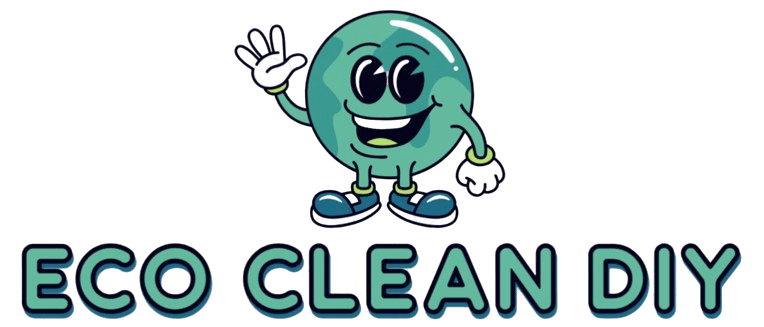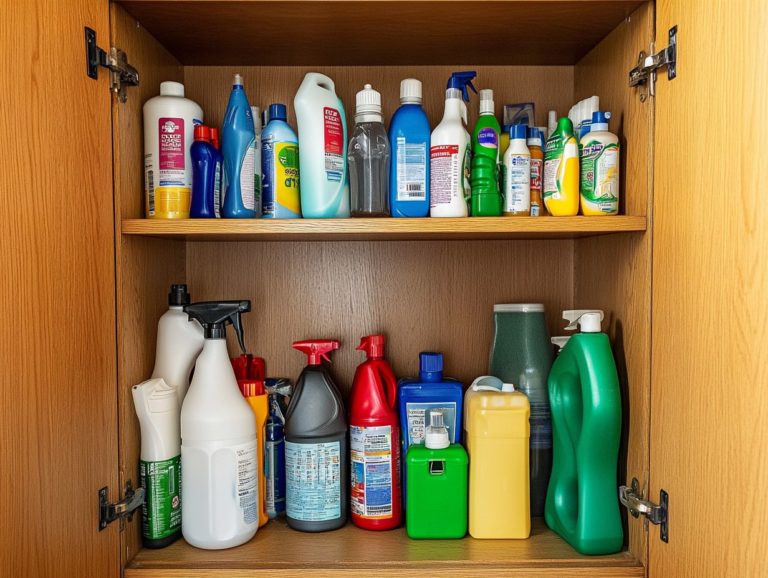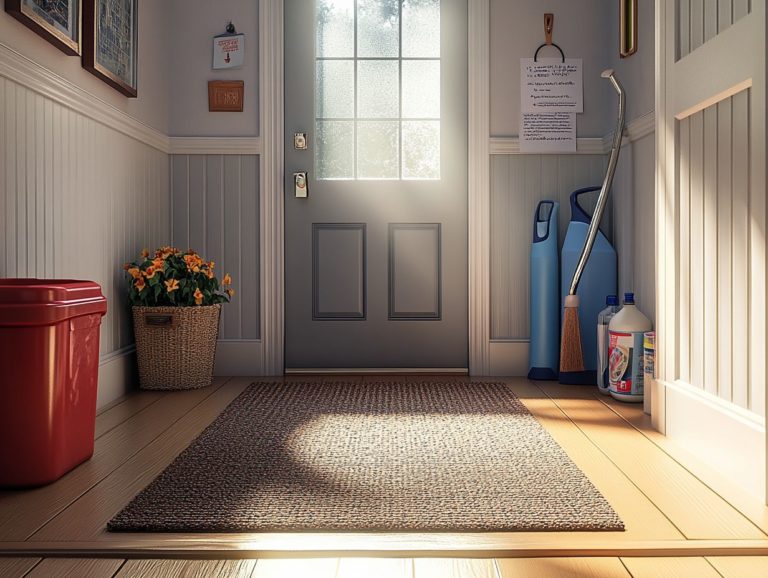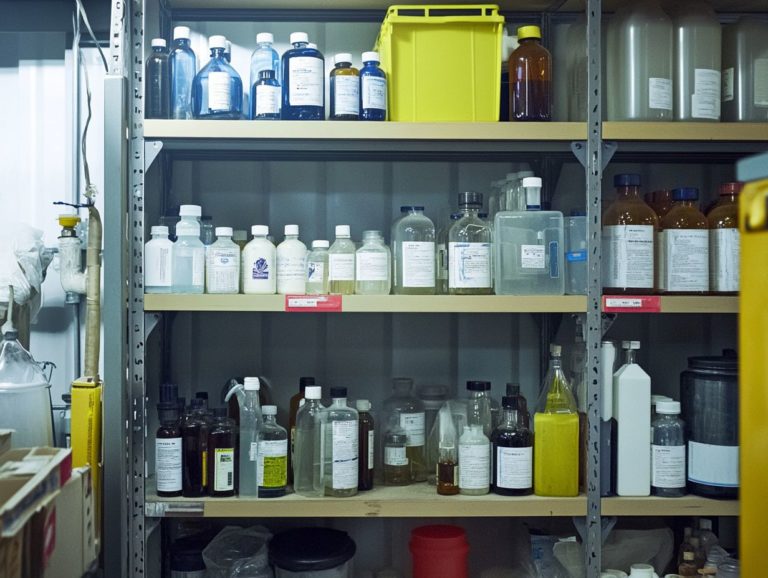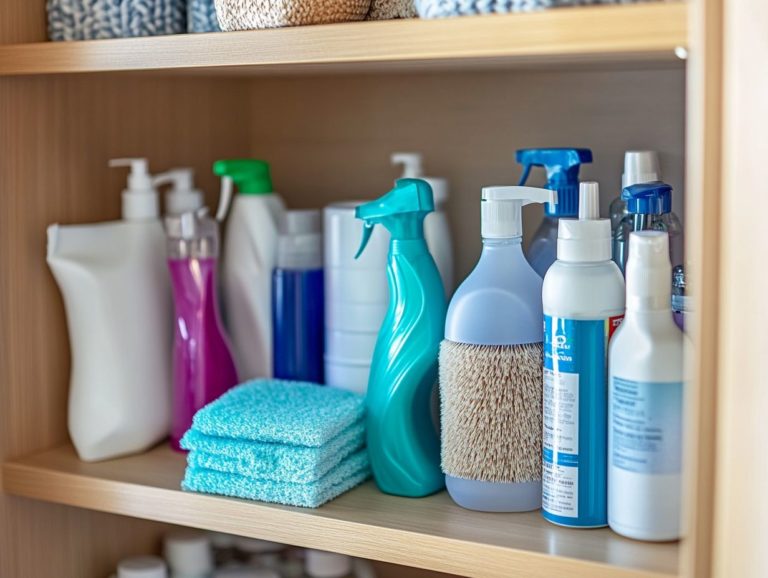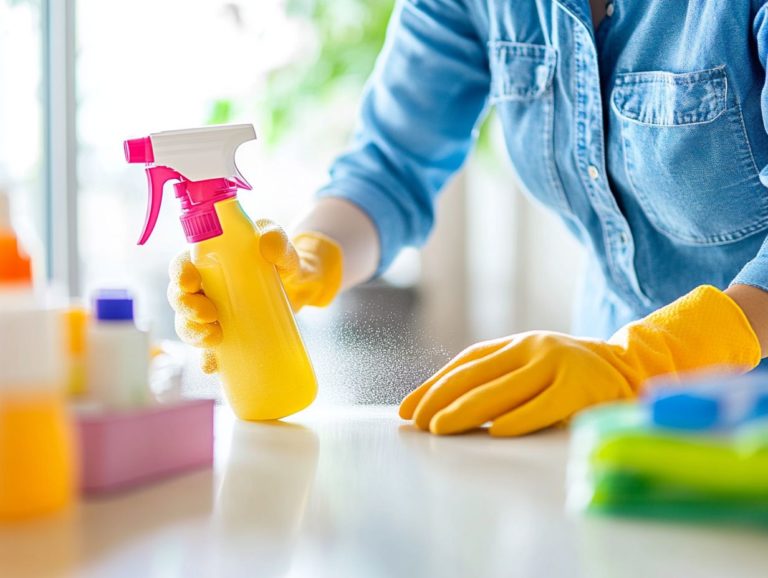How to Ensure Safe Handling of Cleaning Supplies
Cleaning supplies and cleaning products are indispensable for upholding hygiene and cleanliness. Yet improper handling can present notable risks to your health and safety.
This article delves into the significance of safe cleaning supply practices. It highlights the dangers associated with mixing products and cleaning solutions.
You will find practical tips for proper storage, labeling, and usage. The article also provides guidance on what to do in the event of accidental exposure.
Whether in your home or at work, grasping these guidelines is crucial to ensuring the safety of everyone involved. This includes understanding proper handling and chemical safety practices.
Contents
- Key Takeaways:
- The Importance of Safe Handling of Cleaning Supplies
- What are the Risks of Unsafe Handling of Cleaning Supplies?
- How to Properly Store Cleaning Supplies?
- How to Use Cleaning Supplies Safely?
- What to Do in Case of Accidental Exposure to Cleaning Supplies and Chemicals?
- How to Ensure Safe Handling of Cleaning Supplies and Chemicals in the Workplace?
- Frequently Asked Questions
- What are the key steps to ensuring safe handling of cleaning supplies?
- What should be considered when storing cleaning supplies?
- Why is it important to read labels on cleaning supplies?
- What type of protective gear should be worn when handling cleaning supplies and hazardous substances?
- How can proper ventilation help in safe handling of cleaning supplies and cleaning solutions?
- What precautions should be taken when diluting cleaning supplies and chemicals?
Key Takeaways:
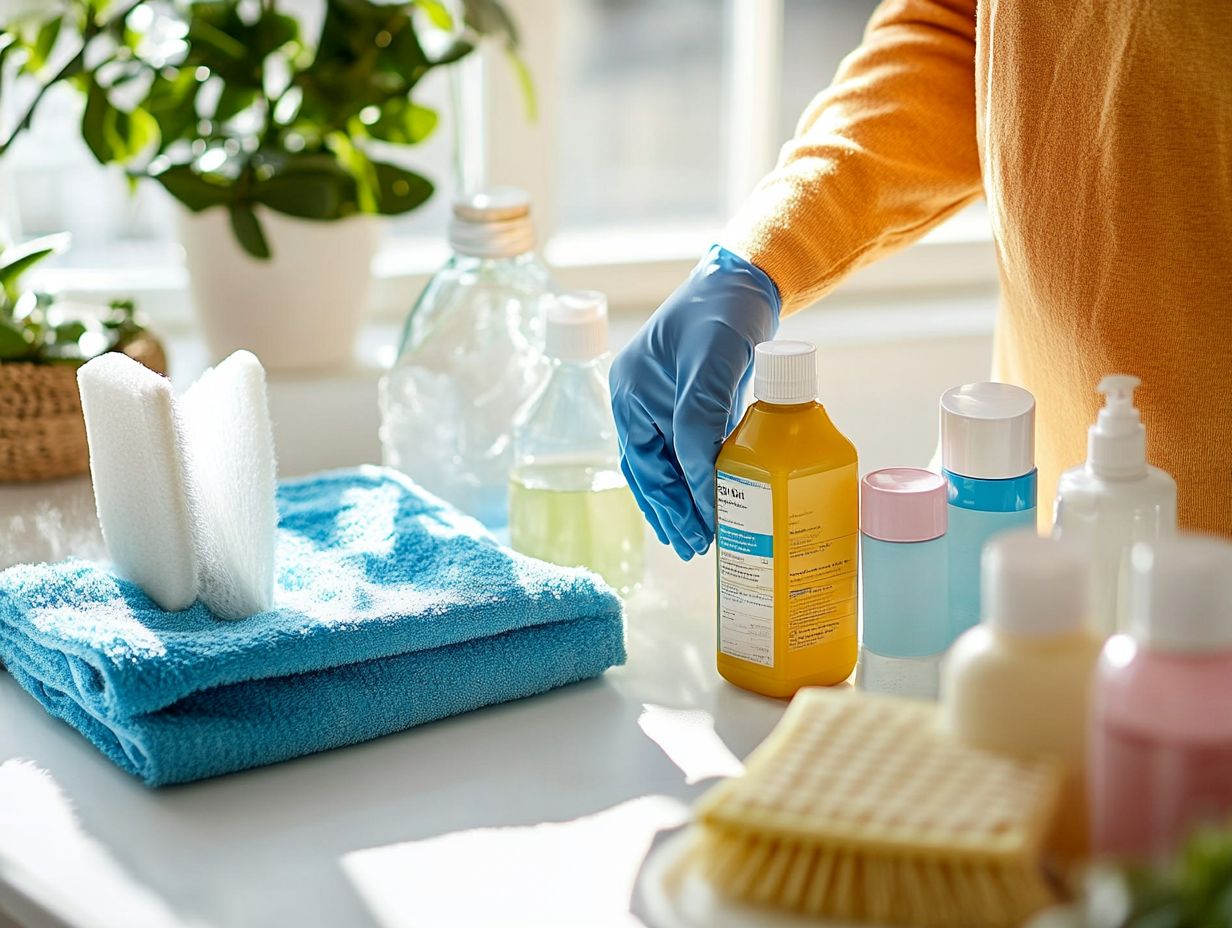
- Keep cleaning supplies locked away from children and pets.
- Always wear safety gear and follow disposal instructions.
- Label and organize supplies clearly; train employees effectively.
The Importance of Safe Handling of Cleaning Supplies
The significance of safely managing cleaning supplies in the workplace cannot be overstated. Improper handling of these products can lead to serious health risks, accidents, and breaches of safety protocols.
Prioritizing proper chemical safety is crucial for fostering a secure environment for all employees. This can be achieved through the effective organization of cleaning supplies, proper storage of cleaning products, and adherence to safety rules, like those set by OSHA (Occupational Safety and Health Administration).
Implementing thorough employee training on handling cleaning chemicals enhances safety. This includes hazard communication and the use of proper personal protective equipment.
Such training can greatly reduce the associated dangers, ultimately enhancing both workplace safety and hygiene.
What are the Risks of Unsafe Handling of Cleaning Supplies?
Unsafe practices when handling cleaning supplies can introduce a range of risks, particularly severe health effects stemming from improper use and exposure to hazardous chemicals. If safety measures aren t followed, employees may suffer the consequences of misuse.
This could lead to issues like chemical burns, respiratory problems due to inadequate ventilation, and even long-term health complications. Routine inspections and adherence to proper chemical handling procedures are essential for mitigating these risks.
Understanding these risks is crucial for protecting your team and ensuring a safe workplace. This approach minimizes chemical exposure and accidents while significantly enhancing workplace hygiene.
What are the Dangers of Mixing Different Cleaning Products?
Mixing different cleaning products can lead to dangerous chemical reactions, resulting in the release of harmful gases and hazardous chemicals that pose significant health risks. Many common cleaning supplies contain ingredients that, when combined, produce toxic fumes or corrosive substances.
For example, when you combine bleach containing sodium hypochlorite with ammonia, you could produce chloramine vapors. These vapors may lead to respiratory distress and potential lung damage. Similarly, mixing different types of drain cleaners can create heat and pressure, resulting in splattering or even explosions.
To prevent these hazardous situations, always refer to safety data sheets (SDS), which provide crucial information about the chemical properties and dangers of each product. Proper labeling, effective organization, and dedicated storage for cleaning supplies can significantly reduce the risk of accidental mix-ups.
By prioritizing safety and staying informed, you can ensure a healthy work environment free from the risks associated with chemical reactions.
What are the Health Hazards of Using Cleaning Supplies?
Using cleaning supplies without a solid understanding of their ingredients and potential health risks can expose you to serious chemicals and long-term health effects. Cleaning chemicals, especially those containing hazardous substances, can lead to respiratory issues, skin irritation, and a host of other health complications if not managed properly.
Hazards such as these necessitate proper safety measures and safety signs. It s crucial to consult safety data sheets (SDS) and wear personal protective equipment (PPE), which includes items like gloves and goggles, when dealing with these products to minimize risks and maintain a safe working environment.
Training employees about the dangers of chemicals is important for promoting safety and awareness in the workplace. When your team is well-informed about the specific hazards linked to various cleaning agents, they can appreciate the importance of adhering to safety protocols and utilizing proper protective equipment.
Adopting proper handling techniques is essential. Emphasizing the use of the right PPE such as gloves, masks, and goggles can significantly lessen the chances of accidents or health problems stemming from misuse.
Cultivating a culture of safety not only protects employee health but also boosts overall productivity and morale in the workplace. Consistent use of PPE and safety protocols is essential for employees dealing with daily-use products and deep cleaning tasks.
How to Properly Store Cleaning Supplies?
Storing cleaning supplies correctly is vital to keeping your workplace safe! Proper storage of cleaning supplies is essential for maintaining workplace safety and preventing accidents that can occur from the mishandling of cleaning chemicals.
It s vital to ensure that these products are kept in designated storage areas that comply with safety protocols, especially when it comes to flammable materials.
Act now by employing effective storage solutions! Utilizing efficient storage methods can further enhance safety by reducing the risk of spills, leaks, and other mishandling issues.
By maintaining an organized system, you enable cleaning staff to easily access the supplies they need while significantly reducing the risks associated with spills, leaks, and chemical reactions.
Regular cleaning inspections can help ensure these systems are functioning optimally, maintaining a secure environment.
What are the Best Practices for Labeling and Organizing Cleaning Supplies?
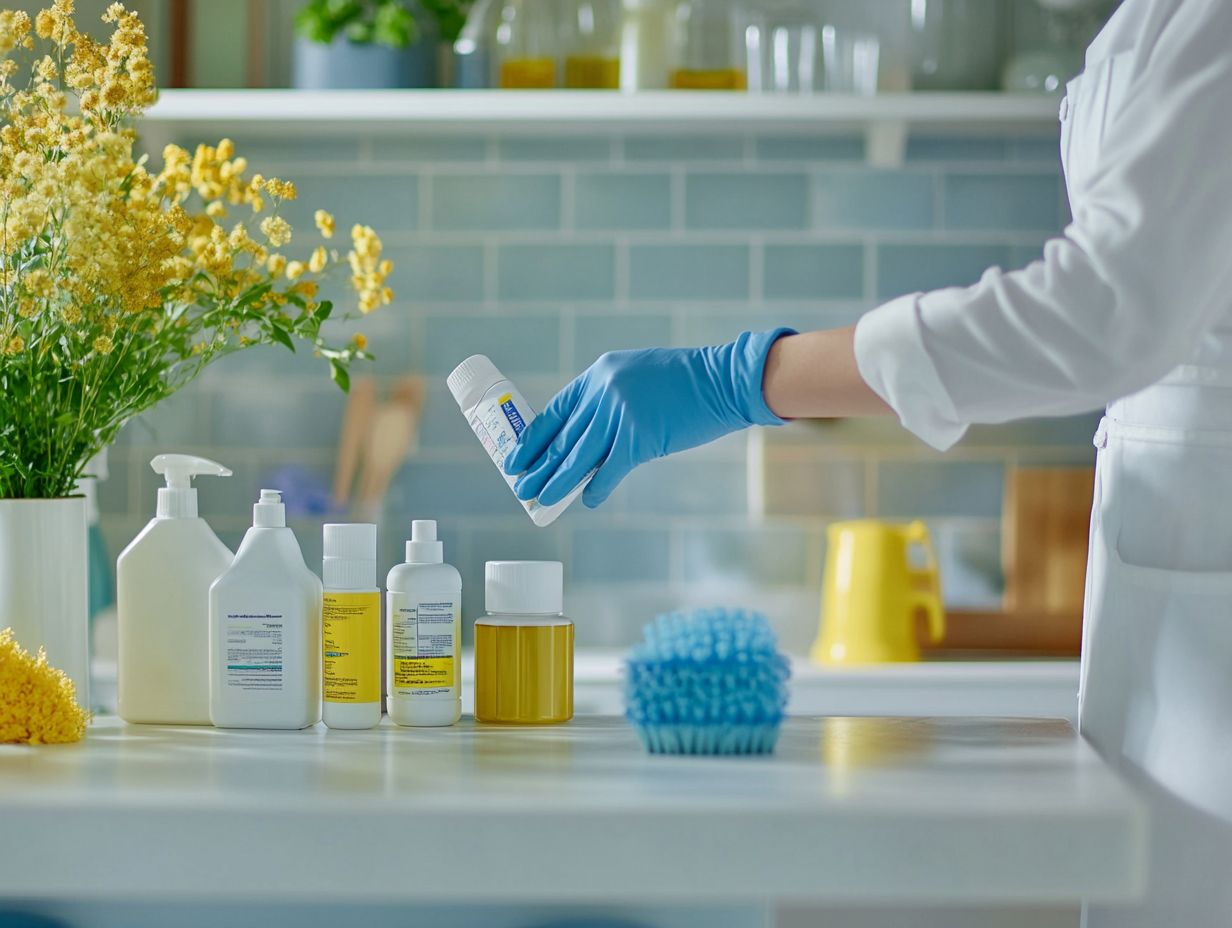
Best practices for labeling and organizing your cleaning supplies are essential to ensure that your cleaning staff can efficiently identify and utilize the right products while minimizing the risk of accidents or misuse.
Clear labels, complete with safety data sheets and hazard communication information, are vital to informing your employees about the properties and risks associated with each cleaning product. Properly organizing your supplies not only promotes effective handling but also enhances workplace hygiene and safety.
To achieve this, ensure that each label includes not just the product name and usage instructions, but also relevant hazard symbols, precautionary statements, and first-aid measures.
Access to safety data sheets should be readily available, either in printed form or in a digital format that all team members can easily access. Incorporating signal words and other safety indicators can help reinforce hazard communication.
Organizing cleaning supplies in designated, clearly marked areas reduces confusion and streamlines workflow, making it easier for your employees to find what they need quickly.
Implementing comprehensive training programs that emphasize hazard communication and proper cleaning procedures is crucial in fostering an environment where safety becomes a shared responsibility among all staff.
Take steps today to improve your cleaning supply storage!
How to Store Cleaning Supplies Safely Away from Children and Pets?
Storing your cleaning supplies safely away from children and pets is a vital safety measure to prevent accidental exposure to harmful cleaning chemicals. By implementing effective storage solutions, such as locked cabinets or designated areas, you can ensure that hazardous substances are kept out of reach of curious hands and paws.
Setting up safe places to store cleaning supplies is essential for maintaining a safe environment. It’s crucial to incorporate workplace safety protocols that include guidelines for securing these supplies, protecting not just your family at home but also employees in commercial environments. Regularly updating and reviewing safety guidelines can also help ensure compliance with the latest standards.
Regularly evaluating the effectiveness of your storage methods is crucial. Make sure that locks are functioning properly and that containers are clearly labeled. Keeping cleaning products in their original containers can significantly reduce risks, as these often contain essential safety information. Routine inspections can help maintain high standards of safety and compliance.
Consider using cabinets equipped with childproof locks or placing heavier items on top shelves to further deter access. Establish a routine inspection schedule to maintain safety standards and foster a sense of accountability among cleaners and caretakers alike. Routine inspections ensure that cleaning supplies are stored safely and securely, minimizing the risk of accidents.
How to Use Cleaning Supplies Safely?
To ensure the safe use of cleaning supplies, it’s crucial to know the right cleaning procedures and recognize the importance of utilizing personal protective equipment (PPE) throughout your tasks. This includes understanding the risks associated with chemical handling and taking appropriate safety measures.
By adhering to established safety measures, you can effectively manage cleaning products while minimizing the risks associated with chemical exposure, accidents, and potential health effects. Implementing safety guidelines specific to your cleaning strategies can help ensure a secure environment.
Comprehensive training on the safe handling of cleaning supplies not only elevates workplace hygiene but also cultivates a strong culture of safety within the cleaning industry. Are your cleaning supplies secured? Check out ways to secure your cleaning supplies and make sure they are!
What are the Recommended Protective Gear for Handling Cleaning Supplies?
When handling cleaning supplies, it s essential to equip yourself with the right protective gear think of it as your personal armor against potential chemical exposure and health risks. Your protective gear arsenal includes:
- Gloves
- Goggles
- Respiratory masks
- Protective clothing
All of these play a vital role in ensuring your safety while dealing with cleaning chemicals. Utilizing the proper PPE is crucial for maintaining health and safety in the cleaning industry.
By following rigorous safety protocols and donning the appropriate personal protective equipment (PPE), you can significantly reduce the hazards associated with cleaning supplies and cultivate a secure working environment. Additionally, learning how to safely rotate cleaning supplies is crucial to prevent accidental exposure and maintain workplace safety.
These specific types of PPE are critical, as they cater to the various cleaning tasks you might face. For instance, working with powerful solvents or acids calls for more robust gloves and adequate respiratory protection. When dealing with bleach or ammonia, it’s imperative to wear goggles to shield your eyes from splashes and harmful fumes.
Additionally, ensuring proper ventilation in work areas is essential to mitigate the inhalation of harmful fumes. Understanding the significance of each protective item and how to use them correctly can have a profound impact on safeguarding yourself against dangerous interactions. This includes recognizing signal words on product labels that indicate the level of hazard associated with cleaning chemicals.
Routinely assess the effectiveness of your safety gear and cleaning equipment to reinforce your commitment to maintaining a clean and secure workspace. This diligence allows you to focus on your tasks with peace of mind, knowing that your health is well-protected. Take these steps today to ensure your home is safe from harmful cleaning products!
What are the Steps for Properly Diluting Cleaning Products and Solutions?
Diluting cleaning products correctly is crucial for safe and effective cleaning! It ensures their effectiveness while minimizing risks associated with concentrated cleaning chemicals. As a member of the cleaning staff, follow the instructions in the product’s Safety Data Sheets (SDS) and adhere to established rules for talking about dangerous chemicals.
Before starting, read the SDS carefully to understand the product’s hazards and proper handling methods. Accurate dilution ratios are critical. Even slight deviations can lead to reduced efficacy or increased safety risks.
Use precision tools like graduated cylinders or measuring cups to ensure you combine the right amount of water and cleaning solution. This careful approach helps avoid misuse and keeps cleaning solutions effective.
Wearing appropriate Personal Protective Equipment (PPE) is crucial to safeguard against potential exposure. Communicate clearly with your team about these safety practices. This not only reinforces a culture of safety but also helps address concerns swiftly.
Regular training on chemical handling and emergency medical care is essential for preparedness.
What are the Safe Methods for Disposing of Cleaning Supplies and Hazardous Chemicals?
Safe disposal methods for cleaning supplies and hazardous chemicals are vital to mitigate health risks and environmental hazards. Ensure that cleaning staff follow established safety measures and comply with local regulations regarding disposal.
Implement effective disposal practices to maintain compliance with safety protocols and foster a secure environment. Understand proper storage locations for different types of hazardous materials to prevent accidental mixing and spills.
Staff must familiarize themselves with guidelines for segregating hazardous materials from regular waste. Improper mixing can result in dangerous chemical reactions.
Utilize designated collection containers and label them clearly. Routine inspections of storage areas ensure ongoing compliance with safety guidelines.
Employees should receive training on recycling opportunities for non-hazardous cleaning supplies to further reduce environmental impact.
Don t delay! Timely disposal is critical for safety. Partner with certified disposal companies to ensure adherence to local regulations and promote a culture of safety and responsibility throughout the workplace. When possible, use eco-friendly products to minimize the environmental impact of disposal.
What to Do in Case of Accidental Exposure to Cleaning Supplies and Chemicals?
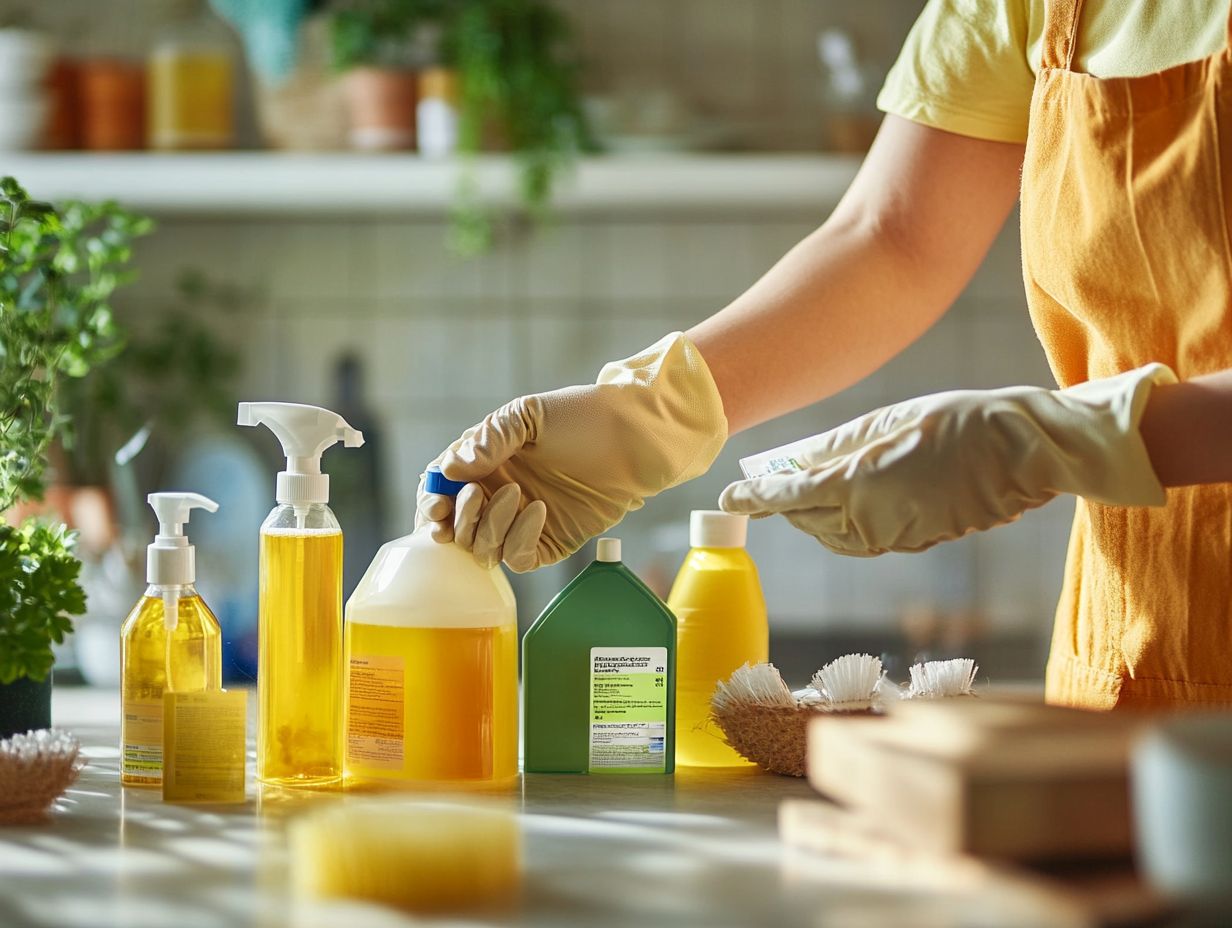
In the unfortunate event of accidental exposure to cleaning supplies, swift action is essential to minimize health risks and protect the affected individual. Immediate response can prevent the escalation of symptoms and reduce long-term health effects.
Adhere to established safety protocols, such as rinsing the affected area with water in cases of chemical burns, or providing necessary emergency care. Clear visibility of safety signs helps ensure quick and appropriate responses.
Equip employees with training on appropriate first aid measures. This is vital for a safe workplace environment and prepares them for potential incidents involving cleaning products. Follow OSHA guidelines rigorously to ensure compliance and safety.
What are the Symptoms of Chemical Exposure from Cleaning Supplies and Products?
Symptoms of chemical exposure vary based on the products used and the level of exposure. Common symptoms to watch out for include skin irritation, respiratory difficulties, headaches, and nausea. These can greatly affect your health and productivity in the workplace.
Recognizing these symptoms is essential. It allows you to implement immediate safety measures and ensure that affected individuals receive proper care. Effective organization of first aid supplies and cleaning stations can aid in rapid response to exposure incidents.
Prolonged exposure to certain chemicals can escalate into more severe health issues, such as chronic respiratory diseases, which refer to long-term breathing problems that can severely impact health, or skin conditions. Employers and employees must be alert to protect everyone’s health! Early detection can facilitate prompt intervention and help prevent long-term health complications.
Following safety rules for handling and storing supplies is key to minimizing the risks of prolonged exposure. Compliance with safety standards is not just a checkbox it s vital. It protects workers and cultivates a safer environment that ultimately enhances overall productivity.
Regular cleaning inspections can help ensure ongoing adherence to these standards and identify potential areas for improvement. Training and awareness programs are crucial, equipping you with the knowledge needed to effectively identify these symptoms and take action when necessary.
What are the First Aid Measures for Chemical Exposure and Burns?
First aid measures for chemical exposure from cleaning supplies are essential for minimizing health risks. Your immediate action is crucial: rinse exposed skin with water right away, remove any contaminated clothing, and seek emergency care if symptoms persist or worsen.
By adhering to established safety protocols and providing thorough training on first aid measures, you can equip cleaning staff to respond effectively to incidents of chemical exposure. This training should also cover the risks of flammable materials and the appropriate actions to take in such scenarios.
Being prepared is vital in reducing the severity of injuries that can arise from various chemical agents. For example, if someone experiences respiratory distress, moving them to fresh air immediately can significantly alleviate their symptoms.
Having a clear understanding of the specific cleaning materials used and their associated hazards enables you and your staff to make informed decisions quickly. Regular training sessions, along with routine drills, will reinforce these crucial skills and ultimately ensure a safer working environment.
Incorporating training resources from reputable sources like the National Safety Council can enhance the quality of these sessions. These proactive measures not only protect the health of individual employees but also contribute to a robust safety culture within the organization, fostering vigilance and a sense of responsibility among all team members.
How to Ensure Safe Handling of Cleaning Supplies and Chemicals in the Workplace?
To ensure the safe handling of cleaning supplies in your workplace, a comprehensive approach is essential. This involves not just employee training but also strict adherence to safety protocols and the establishment of a robust chemical safety program.
Partnering with industry leaders like Midlab, FlexMax, and Lavo Solutions can provide valuable insights and resources for maintaining high safety standards. By educating your cleaning staff on proper handling techniques and the potential risks associated with cleaning chemicals, you can cultivate a culture of safety that significantly reduces accidents and health hazards. Understanding the importance of cleaning supply safety is essential in this process.
Incorporating effective training resources alongside regular routine inspections will further elevate workplace hygiene and ensure compliance with safety standards. Utilizing green cleaners whenever possible can also contribute to a healthier workplace environment.
Stay informed and ensure safety protocols are followed diligently!
What are the Safety Precautions for Employees Handling Cleaning Supplies and Chemicals?
Safety precautions for those handling cleaning supplies are crucial. They help prevent chemical exposure and ensure a safe workplace. Always use safety gear like gloves and goggles, adhere to manufacturer guidelines, and understand the risks associated with cleaning chemicals.
Knowledge of proper storage and disposal practices is equally important to mitigate potential hazards. Cultivating a proactive safety culture helps reduce the likelihood of accidents and injuries among your cleaning staff.
Implementing clear safety signs around work areas serves as constant reminders of safe practices. It s essential that employers provide comprehensive training on the proper use of PPE, such as gloves, goggles, and respirators, to shield against potential hazards.
Equally important is the implementation of clear hazard communication practices that keep you informed about the specific chemicals you’re using and the potential risks involved. Regular updates to the Safety Data Sheet (SDS) ensure that all team members have access to the latest safety information.
By ensuring that these measures are thoroughly understood and practiced, workplaces not only elevate their safety standards but also promote the overall well-being of their employees. This creates an environment where individuals feel protected and supported in their roles, fostering a sense of security and confidence in their work.
Regular cleaning inspections are not just important they are essential to ensure safety and identify areas needing improvement.
What are the Guidelines for Properly Training Employees on Handling Cleaning Supplies and Chemicals?
Your guidelines for effectively training employees on handling cleaning supplies should include a thorough education on safety protocols, proper use of personal protective equipment, and a solid understanding of the properties of cleaning chemicals.
A well-structured chemical safety program will feature hands-on training sessions, easily accessible training resources, and regular updates to keep your cleaning staff informed about best practices, hazard communication, and chemical handling.
By prioritizing employee training, you can significantly enhance workplace safety and minimize the risks associated with cleaning supplies, hazardous chemicals, and overall workplace hygiene.
Robust training programs do more than just equip employees with essential knowledge; they cultivate a culture of safety and responsibility throughout the workplace. Establishing clear communication channels empowers employees to report hazards or near-misses without hesitation, ensuring ongoing improvements in cleaning operations and workplace hygiene.
Routine inspections and safety data sheets should be part of these improvements to maintain a secure environment. Regular refresher courses and updates will keep your workforce up-to-date on new cleaning techniques, evolving regulations, and emerging safety protocols.
This commitment to continuous education is vital for promoting a safer environment for both your employees and clients, ultimately enhancing the overall effectiveness of your cleaning operations. Keeping up with OSHA guidelines and utilizing green cleaners can also contribute to a safer and more eco-friendly workplace.
Frequently Asked Questions

What are the key steps to ensuring safe handling of cleaning supplies?
The key steps to ensuring safe handling of cleaning supplies include proper storage, label reading, protective gear usage, ventilation, dilution, and following manufacturer instructions.
What should be considered when storing cleaning supplies?
Cleaning supplies should be stored in a cool, dry, and well-ventilated area, away from direct sunlight and heat sources. They should also be kept out of reach of children and pets.
Why is it important to read labels on cleaning supplies?
Labels on cleaning supplies provide important information such as proper handling and storage instructions, potential hazards, and first aid measures. Reading labels can help prevent accidents and ensure safe usage.
What type of protective gear should be worn when handling cleaning supplies and hazardous substances?
Protect yourself! Always wear gloves, goggles, and masks when handling cleaning products to protect your skin, eyes, and respiratory system from potential chemical exposure.
Choose your gear based on the cleaning product. Safety signs should be displayed prominently to remind staff of the required gear.
How can proper ventilation help in safe handling of cleaning supplies and cleaning solutions?
Proper ventilation is crucial. Open windows to ensure good air circulation and minimize health risks. Use fans to enhance airflow while cleaning, preventing harmful fumes and vapors from building up.
What precautions should be taken when diluting cleaning supplies and chemicals?
When diluting cleaning products, always add the cleaning product to water, not the other way around. This prevents splashing and potential chemical reactions.
Use the correct ratio of cleaning product to water as instructed on the label. Warning labels provide crucial information on the proper handling and dilution of cleaning chemicals.
